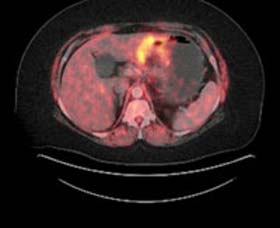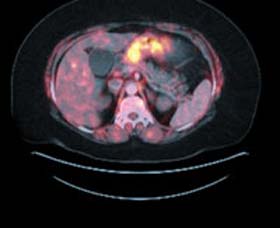A 43-year-old woman presents with nausea and vomiting
A 43-year-old woman with a history of obesity presented with one month of nausea, vomiting and an inability to eat. The patient reported that upon swallowing any food, she developed pain in her mid-abdominal region. She subsequently had multiple episodes of emesis, including some episodes with hematemesis and coffee ground emesis. She reported that she has lost an unspecified amount of weight during the last month. She subsequently sought medical attention. A CT scan of the abdomen and pelvis was performed revealing a distended stomach, antral mass and an enlarged celiac lymph node. An upper endoscopy was performed revealing tumor in the antrum. Biopsies were positive for adenocarcinoma. A PET/CT scan revealed hypermetabolic activity in the gastric antrum. There was no fat plane between the thickened posterior gastric antral wall and anterior pancreas. There was also hypermetabolic activity within the gastrohepatic ligament lymph nodes and aortocaval lymph nodes at the level of the renal veins worrisome for metastatic disease.
The patient’s past medical history was significant for obesity. Her family history was remarkable for the death of her father three months prior due to a cancer of unknown primary.
Her current medications include Percocet as needed for pain and prochlorperazine for nausea.
On evaluation by surgical oncology, the patient was felt not to be a surgical candidate.
What will you do next?
A. Treat with epirubicin, cisplatin and fluorouracil.
B. Treat with epirubicin, oxaliplatin and fluorouracil.
C. Refer to radiation therapy for combined radiation and fluorouracil.
D. Best supportive care.
|
|
|
|
Figures 1 and 2: PET/CT at the time of
diagnosis
Source: A. Blaes |
|
CASE DISCUSSION
Gastric cancer is a highly lethal malignancy. The five-year survival for patients with gastric cancer is approximately 22%, according to data from the NCI SEER Program. Despite national and international trials, little improvement in overall survival has occurred in the last five decades.
In patients with locally advanced gastric cancer, the goal of treatment is surgical cure. Although surgery alone results in poor long-term survival rates, both adjuvant and neoadjuvant treatment strategies involving chemotherapy and radiation therapy are being investigated. Despite a number of trials, no consensus currently exists as to the best regimen for treatment. In this setting, enrollment in a clinical trial is advised when clinically available.
In patients who have surgically unresectable disease such as our patient, the long-term goal is symptomatic relief in conjunction with the prolongation of life. A number of phase-2 and phase-3 trials have been performed to evaluate whether patients benefit from chemotherapy more than best supportive care. In a large meta-analysis performed by Wagner et al, patients who received chemotherapy had an improved OS compared with those who received best supportive care (HR=0.39). When a subsequent analysis was performed to determine whether patients received single agent vs. combination chemotherapy, which consisted predominantly of 5-FU-based therapies, patients with combination chemotherapy appeared to benefit over those who received single-agent chemotherapy (HR=0.83). The group with the largest advantage appeared to be those who received therapy with cisplatin, an anthracycline and 5-FU. Although combination chemotherapy was more favorable than single-agent treatment, this ultimately translated into only a one-month survival advantage.
Until recently, there have also been questions as to whether oral fluoropyrimidines appeared to be as effective as continuous infusion 5-FU. There were also questions as to whether patients may benefit from receiving oxaliplatin instead of cisplatin. The REAL-2 trial published results in the last year. This phase-3 trial, with a 2 × 2 design, randomly assigned 1,002 patients with advanced gastric cancer to three weekly cycles of epirubicin 50 mg/m2 plus cisplatin 60 mg/m2 plus either capecitabine 625 mg/m2 twice daily (ECX) or continuous 5-FU infusion 200 mg/m2 daily (ECF) or epirubicin plus oxaliplatin (130 mg/m2) plus either capecitabine 625 mg/m2 twice daily (EOX) or continuous 5-FU infusion 200 mg/m2 daily (EOF). There was no difference in response rates or progression free survival between the four different treatment arms of the study. When evaluated more closely, however, the median survival in patients treated with oxaliplatin (EOX) was 11.2 months compared with 9.9 months when treated with cisplatin (ECF) (HR=0.80).
Additional studies have been conducted evaluating whether taxanes are also beneficial in this setting. The TAX-325 trial randomized 457 patients to placebo or cisplatin 75 mg/m2 day one and 5-FU 750 mg/m2 days one through five every 21 days plus docetaxel 75 mg/m2 (DCF) on day one. The response rates and two-year survival favored docetaxel. In this trial, however, the degree of grade-3 and grade-4 toxicities was high. At this point, no trials comparing EOX with DCF have been published.
In our patient, we initiated treatment with epirubicin, oxaliplatin and 5-FU. For insurance reasons, the patient was placed on continuous infusion 5-FU as opposed to capecitabine (Xeloda, HLR). Treatment with epirubicin, cisplatin and 5-FU would also be a reasonable option; however, based on results of the REAL-2 trial, there appears to be a trend towards improved survival with the use of oxaliplatin over cisplatin. The use of combined chemotherapy and radiation would be reserved for neoadjuvant or adjuvant treatment in conjunction with surgical resection.
Anne H. Blaes, MD, is a Fellow at the University of Minnesota and a member of the HemOnc Today Editorial Board.
For more information:
- NEJM. 2008;358:36-46.
- J Clin Oncol. 2006;24:2903-2909.


